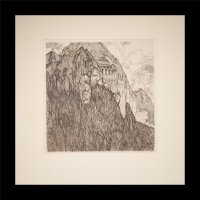Etchings of Creative Forces by the significant artist and native of Most, Wenzel Hablik
› Detail › Etchings of Creative Forces by the significant artist and native of Most, Wenzel HablikExhibit of the Month 10 / 2023
The Exhibit of the Month presents a selection of three etchings from the cycle Creative Forces (Schaffende Krafte) by the significant artist, native of Most, Wenzel Hablik (August 4, 1881, Most – March 23, 1934, Itzehoe). The entire cycle is from 1909 and features delicately crafted graphics resembling a kind of fantastical landscape, where various natural forms of crystals appear. Hablik himself recalled a crystal he found in his youth in the Ore Mountains, which also inspired the exhibited graphics as well as his other works. His very first architectural drawings featuring crystal motifs appeared as early as 1902. The exhibited collection, from which the etchings originate, was already acquired into the old museum fund and represents a rare complete set by this author. It is also the very first series of his graphics in which he presented the clash of creative forces with inanimate matter. The structures of fantastical buildings, which he compressed into recurring rocky crystalline formations, are repeated in the individual etchings and essentially anticipate his later architectural work. Thus, Hablik's designs for truly visionary buildings appear in the work. Perhaps for this reason, only the facade of his house was realized according to his design.
source: wikipedie.org
Wenzel Hablik was very versatile. He engaged in painting, architecture, graphics, but he was also a jeweler and textile artist. Together with his wife, textile artist and designer, Elisabeth Hablik Lindemann, they established a studio where they designed tapestries, table textiles, as well as cutlery, jewelry, decorative items, and everyday necessities. With his wife, thanks to their supporters, he undertook several trips in search of inspiration for their further work (to South America, India, and the Azores).
However, the war and post-war events caused this exceptional artist to be forgotten, and for a long time, he remained among the undervalued artists. The professional public began to rediscover him only in the 1980s and 1990s thanks to foreign exhibitions of Expressionism or interwar art. Today, he is considered one of the greatest figures of early Expressionism, who advocated for and significantly influenced Expressionist architecture.
He remained in contact with his homeland, which was always an important source of inspiration for him. From 1902 until his death, Wenzel Hablik created about 600 oil paintings, of which approximately 250 are known today. He died prematurely in 1934 from cancer. He only had exhibitions in his native Most after his death. In 1995, the Wenzel Hablik Museum was opened in the House of Art in Itzehoe, which owns an extensive collection of his paintings, graphics, drawings, as well as examples of his designs and realizations in the applied arts. To this day, this museum commemorates his exceptional artistic legacy.
Text: PhDr. Olga Kubelková
Photo: Pavel Krásenský
 en
en cs
cs de
de

